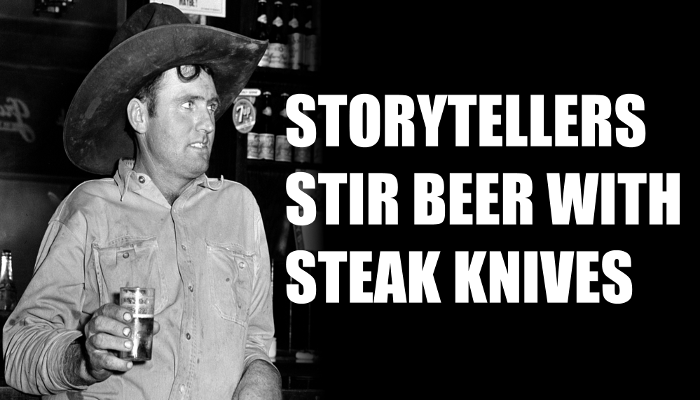
I glanced around the restaurant. Three women occupied a table with a pitcher of light brown beer in the center of it. One of the women poured herself a pint and then did something that I’ve never seen before–she stirred her beer with a steak knife.
I was astonished at how casually she acted. Neither of her companions paid any attention to the odd behavior and so they just continued their conversation. But I couldn’t get over it. I found myself consumed with wanting to know why a person would stir a perfectly good beer with a steak knife. My mind raced. Perhaps it was something cultural–like a toast. Perhaps it was for good luck. I finally settled on a reason when I saw that her actions had created a frothy head. But, just when I thought that I understood her motives, she added another layer to my intrigue by piercing the newly formed foam with a black straw and began sipping beer through it.
![]()
Last Friday, a friend asked me how I created stories. She wanted to know about my process. It wasn’t the first time that I’ve been asked this question. The same question initiated the development of the StoryHow™ PitchDeck.
I described my process as more bottom-up than top-down. I build my stories upon story elements (like in the StoryHow™ PitchDeck) as opposed to top-down such as methods like Joseph Campbell’s, The Hero’s Journey).
I learned this “process” from my grandfather during countless early morning breakfast trips into Boston. Whether we were driving, eating, or walking around the city, he’d quiz me constantly. “Look over there,” he’d say. “You see that old man feeding the pigeons? What’s he doing? Why does he do that?” His questions forced me through an inductive thought process. “Do you think he sits on that bench every day, or is this his first time?”
Then, we’d discuss my answers, which covered a wide range from likely to extravagant.
My grandfather taught me the most important of all storytelling skills…the power of observation. My process is built upon noticing, studying, and then trying to understand the actions of others.
![]()
I never asked the woman why she stirred her beer, so her motivation remains a mystery. But the point is that I found a story seed through the simple act of observation. Observation is the seed of all stories. You plant them into the rich soil of human actions and water them with human desire.
Do you want to be a better storyteller? Stir your beer with a steak knife. Pay attention to the things that everyone around you ignores. You’ll likely find the seed to your next story.
Photo Credit: Lee, Russell, photographer. Cowboy drinking beer in beer parlor, Alpine, Texas. May, 1939. Image. Retrieved from the Library of Congress, https://www.loc.gov/item/fsa1997026146/PP/.